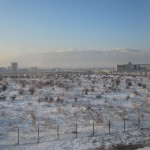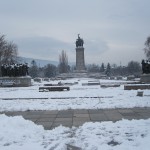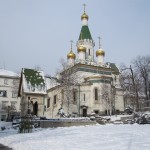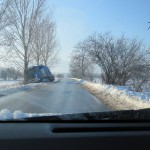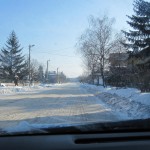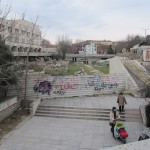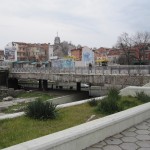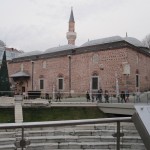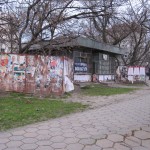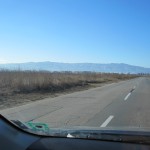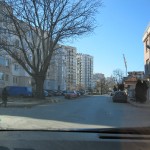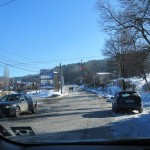Bulgaria 2014-15
CLICK ON PICTURES TO ENLARGE
BULGARIA. 2014 - 15
It was to be an unusually long Christmas break, and I thought it would be a pity to waste it by not going somewhere interesting for at least a few days. Istanbul came to mind, but on further investigation it was going to be expensive and difficult to get convenient flights at short notice. Another place on my list was Bulgaria, which was much cheaper, with flights at sensible times from Gatwick. I had visions of flying to Sofia and driving across to the resorts on the east coast or down to Thessaloniki in Greece, although I was fully aware that Bulgarian winters are hard and these visions might be almost as unrealistic as those of the people who run the European Union.
The first time I heard of Sofia was in the 1960s, on the platform of a railway station somewhere just the other side of the channel. It was a business trip to Austria, and I had one leg in plaster following a skiing accident. My luggage was being taken by a porter to a train alongside which was a man shouting 'Sofia, Sofia', and I thought he was calling to his wife. In the nick of time I realised that it was the name of a place that I did not want to go to, although I had no idea where it actually was.
Back to 2014, and from the weather reports in the British press it appeared that Sofia was a few degrees colder all round than the south coast of England, which is not surprising considering that the city is at an elevation of 500m above sea level and immediately adjacent to a mountain that is used for skiing.
To avoid the horrors of dealing with taxi drivers at 9.00pm in a foreign city I had arranged to pick up a rental car on arrival and just drive to
an airport hotel. This proved to be a very good decision, because there was snow everywhere following a moderate fall the previous day. The recently built IBIS hotel was within the airport complex, easy to find and quite cheap. My second floor room had an expansive view to the south, overlooking Mount Vitosha, with its ski resort.
The plan was to spend the next day (Sunday) looking round the city, which has many splendid buildings, and the following day drive via a country route to Plovdiv, the second city.
Sofia
On the Sunday morning the temperature, at -7 degrees, was lower than it had been in any of the press reports. After the mild winter in the south of England it seemed terribly cold to me, but I set off bravely to drive into the city. The main roads had been cleared fairly well, but the side roads and pavements were covered with snow and ice. As required by law, my excellent Toyota Corolla was fitted with winter tyres, and these gave a better grip than I expected.
Sofia is a compact city, and after finding a parking space not too far from the centre I set off to follow the Lonely Planet Walking Tour, which takes in all the main sights in a distance of about 1.5 miles. The LP guide warns of the bad state of the pavements in Sofia, but did not mention the snow and ice, which were quite lethal. In many places everyone resorted to walking on the road.
I was actually doing the tour in reverse, starting at the Russian Army Monument, which is a typical display of
brutalist Soviet style sculpture in a park. Not far from there is the piece de resistance of the city sights , namely the Alexander Nevsky Memorial Church, which according to experts is a fine example of neo-Byzantine architecture. By this time its biggest attraction for me was that it was comparatively warm inside. Most of the interior was actually one large open space, although it did not actually seem as large as I had expected.
In the square adjacent to the church was an antique market with a considerable quantity of Warsaw Pact militaria, including uniforms, gas masks, and those wonderful ornate Soviet officers’ wide-brimmed caps. If I could think of a suitable occasion to wear it I would get one.
Moving on eastwards the route passes the much smaller Sveti Nicholas Russian Church, with its glittering gold decoration, followed by a string of fine buildings including the National Art Gallery, Archaeological Museum and Presidency. Some of the big names of international business were now in evidence, including, needless to say, McDonalds.
The route passes the Banya Bashi Mosque before finishing at the imposing Sveta Nedelya Cathedral. This is also a typical capital city retail environment out to relieve foreign visitors of their Dollars, Pounds or Euros, with little sign that it is in one of the poorest countries in Europe.
One place I wanted to visit was the Polytechnic Museum which meant a considerable walk through an unsalubrious area of side streets where not much effort had been put into clearing the snow and ice from the pavements. To my total amazement half way along one of these streets I slipped on the ice and fell quite heavily. This was a great surprise, because falling is something that I do not do nowadays, and in my experience when people of my age have a fall like that it is often the beginning of the end.
When I picked myself up it was exactly the same as the feeling I used to get thirty years ago after bad falls or collisions in motorcycle beach racing. I was pretty sure that I had not broken anything, but there was obviously severe bruising and every movement was quite painful.
Anyway, I limped along to the Polytechnic Museum, which at first sight appeared to be closed, with a heavy iron gate across the entrance. When I pushed on the gate it opened and a man in uniform emerged from a gatehouse in the forecourt. I asked him if the museum was open, which led to some confusion because Bulgarians nod their heads when they mean 'no' and shake them when they mean 'yes'.
It appeared that even though the reception area the other side of the forecourt was in total darkness and the doors were locked, the museum was actually open. The man unlocked the doors and went upstairs, reappearing shortly afterwards with a lady who put the lights on and opened up the cash desk. Another lady then appeared and the place was in full swing. The idea of these two ladies locked in a dark building until some visitors turned up was very odd, and might well be the inspiration for a horror film. It seems, however, that this is not unusual in Bulgaria, because on the section on Plovdiv in the LP guide it says “If a museum looks closed during what should be opening hours, bang loudly on the front door”. The Polythechnic Museum is only a small establishment like a very tiny version of the Science Museum in London, but obviously with an emphasis on Bulgarian contributions to technology and there were a few interesting things.
By now I was a considerable distance from the car, but with admirable fortitude I struggled back to it and entered into battle with the inexplicably complicated traffic systems of Sofia. Although walking was quite difficult I did not notice the effects of the fall at all when driving.
During the night a few inches more snow fell, and at breakfast time it was still happening, with the wind howling round the building. I had planned to drive to Plovdiv, Bulgaria's second city, about 90 miles away, but these were not conditions for going any distance, so I decided to make it a day for looking round the shopping malls not far away. At least it would be warm and would not put too much strain on my leg, which was still very painful.
The nearest mall was simply called The Mall, with about 160 shops and restaurants. All very smart and quite upmarket, although it was not in an area easily accessible to foreign visitors unless they had a car. The car park was a mess, with piles of snow around, which didn't matter too much because not many people had turned out anyway. The only thing I was looking for was a supply of English books, in case I was holed up in the hotel for days on end, but there were no bookshops at all. Plenty of jeans, but I had enough of those.
In the much smaller Sky City Mall, not far away, I found two bookshops with an excellent range of English books at the same prices as at home. Two people whose books seem to be published in the local language everywhere in the world were very much in evidence, namely Jamie Oliver and Bear Grylls. Jamie Oliver was also on television when I got back to the hotel. I had no idea that he could speak such good Bulgarian, or that he was a ventriloquist, because he was speaking some of the time without moving his lips. The hotel television offered a limited selection of programmes to suit visitors of different nationalities, the only English one being CNN, which had an American lady with a squeaky voice speculating for hours on end about the fate of a missing airliner in the Far East.
As mentioned above, the road system in Sofia is incredibly complex, perhaps more so than anywhere else I have been. Just finding the way in and out of the shopping malls alongside the main through route was daunting, with a multiplicity of slip roads and tunnels all very close together with few signs.
Bulgarian uses the Cyrillic character set, more or less the same as Russian. On my trip to Russia in 2010 I discovered that if you know the sounds associated with the characters it becomes quite easy to read a lot of words, and it is essential to do that if you are travelling around, especially away from main cities. Before going to Bulgaria I brushed up on my Cyrillic, but not nearly enough, and could only translate by picking off one letter at a time, which is not much good when you drive past a road sign at 60mph.
The opportunity to test this knowledge arose the next day, which was dry and bright, with a bracing -13 degrees when I went out to the car. This was the day for the drive to Plovdiv. The main roads appeared to have been cleared quite well, but most others were completely untreated and still covered with hard packed snow or ice. The main route between Sofia and Plovdiv is a motorway which would undoubtedly be clear, but originally I was intending to use the old road (no. 8) because it runs through villages and towns which would be more interesting. In trying to find the turn off for route 8 I got on to a network of untreated roads with nowhere to stop safely to check my location and very soon came across a big truck in the ditch, with its cab resting against a tree.
Eventually I found route 8, which turned out to be a solid sheet of hard-packed snow, shining in the sun It gave me an insight into the winter rural scene in Bulgaria as it passed through some quite pleasant villages, but it demanded a fair amount of concentration and after about ten miles I decided to go back on to the motorway. This road runs through a wide, flat, valley with snow-capped mountains some distance away on either side, and roughly midway between Sofia
and Plovdiv the snow at the roadside disappeared, as the elevation was much lower than in the Sofia area.
At one point I stopped at a near deserted road house for a cup of coffee, and this confirmed my experience of Bulgarian coffee. If you ask for a cup of coffee you will get about half the quantity that you get in an Espresso in France, ie. about a thimble full. Often the person serving asks whether you want a large one, which is equivalent
to a normal Espresso. The purpose of this offering is not clear, because it is far too little to quench thirst, and it is difficult to see how it can take long enough to drink to have any social value.
Displayed in front of the building was an ancient vehicle of a type that I had seen in less developed countries many times before, but never close up. It was the standard transport used by peasants in days gone by, consisting of the front end of a motorcycle attached to a primitive armchair with a single cylinder engine alongside it and a box at the back for carrying goods. For most people who made a living working small plots of land this would be their only means of getting around and taking goods to market.
Plovdiv
Bulgaria’s second city is different from the capital in many ways. The immediate impression was that it is less advanced, i.e. it is closer to the Soviet era. Sofia has obviously benefitted from a great deal of foreign investment and influence, whereas Plovdiv still has the atmosphere of an old-style East European city. The road system consists mainly of cobbled or roughly-surfaced streets with a few wide main routes. Because of the uncertainty with the weather I had not booked a hotel, but had two three suitable ones in mind, and had marked them on my map. In trying to find the first one I got into a terrible mess at a road junction with traffic lights, finishing up at an angle in the middle with people hooting at me from all directions. It turned out that I had marked the hotel in the wrong place on the map, and when I eventually got there it had a different name from the one I was looking for!
Still, the Park Hotel was extremely good value, and my room had a view over the city, with a go-kart track and
entertainment centre in the foreground. Unlike the IBIS in Sofia, there were several restaurants in the vicinity. After getting sorted I set off to walk into the city centre through about half a mile of streets lined with drab buildings before reaching Central Square, which was dominated by a massive Soviet-style government building incorporating the post office and telephone exchange. In front of it was a large excavation exposing the ruins of the Roman Forum, but the area still had all the characteristics of an east European city, with rubbish in and out of bins, shabby lock-up shops and kiosks, to say nothing of the graffiti. The backdrop, however, was quite pleasant with two areas of high ground nearby, one called Sahat Tepe (Clock Hill ) with a quaint stone tower topped by a radio mast.
Leading north from Central Square is the pedestrianized main shopping street, not exactly chic, as it was described in one guide, but quite smart and with some well-known names. The top end covers the ancient Roman stadium, just a small part of which is visible, and nearby is the Dzumaya Mosque, which is said to be one of the most magnificent Muslim religious buildings on the Balkan peninsular.
I was intending to walk through to the Old Town, but the cough and cold that I had been suffering from for several days finally caught up with me and after a small meal I made my way back to the hotel. On the way I came across a wonderful eyesore, just the sort of thing that the tourist authorities in foreign cities complain about visitors taking photographs of, rather than nice things like flowers in a park. It consisted of a dilapidated and derelict lock-up shop in the middle of a mess of hoardings, rubbish and graffiti. Nearby was a car park with four non-running relics of the Cold War motoring era, namely a Trabant, Wartburg, Moskvitch and early Lada. Such vehicles are seldom seen on the road nowadays, and this was obviously someone’s personal collection.
Originally I was going to drive back to Sofia the next day, but the weather forecast seemed positive that there would be no snow in the next few days, so after breakfast I asked the people in the hotel reception if I could stay another night. Unfortunately the Park Hotel did not have any vacancies, but they arranged for me to stay at the Imperial, a much larger, recently-built hotel about ten minutes’ drive away.
I left the car there and set off to walk to the Old Town, but the temperature was still a few degrees below zero, and after about half an hour of
constant coughing I was just not well enough to continue. Most of the rest of the day was spent in my room with books and the TV, which luckily had a normal range of programmes rather than the special hotel fare in the IBIS. This was certainly not the way I had hoped to spend my limited time in Bulgaria.
The next morning I left early and drove through to the Old Town, with its cobbled streets and quaint buildings. It actually covers quite a small area, but I can understand why it is so highly rated as a tourist attraction. The main river in Plovdiv is the Maritsa, which varies greatly in width as it runs along the valley between the mountains, and is quite wide as it passes through the city centre area, providing excellent views from the some of the bridges.
About 25 miles west of Plovdiv on route 8 towards Sofia is the town of Pazardzik which I thought might be worth seeing as an example of a smaller town. Route 8 out of Plovdiv was flat, straight and boring. For some
inexplicable reason about 5 miles from Pazardzik it was closed completely, with a long diversion over minor roads. As I approached Pazardzik a vast Soviet-style housing complex came into view, with the usual grim blocks
of flats, more grim even than the rest of the town. However, the centre does have some reasonably pleasant pedestrianized streets and a few attractive buildings, as well as the river Maritsa. Apparently the local economy is fairly sound, with hydro-electric plants, copper-mining, a big pharmaceutical factory and textile manufacture.
As previously mentioned, Mount Vitosha, with its ski resort, rises up from the valley on the south side of Sofia, and before going into the city I decided to take a look at the mountain. Along the valley between the mountain and the city a modern high-speed by-pass road is lined with an astonishing amount of industrial and commercial development, including , IKEA, Decathlon and yet another shopping mall. Finding a way out of it to the mountain was not easy, but eventually I managed to get up to a place called Simeonovo, where the gondala to the ski slopes crossed the road.
The whole character of the area here was completely different from the rat race of the by-pass a few minutes away, with the atmosphere of approaching a ski resort, although it was not possible to drive to the top station of the gondola. In any case, it was getting late and I still had to fight my way across Sofia to the airport hotel.
With all the ice and snow still around the car looked as if it had been on a 2000 mile rally, and it was a great puzzle when I took it in to the rental company the next morning to understand how it had somehow cleaned itself. Presumably it must have rained in the night, but the man from Auto-Jet Car Rental was delighted.
Due to the weather and my state of health I had seen and done far less in Bulgaria than I had hoped, although I was aware that it was a risk going in the middle of the winter, and I could have been stuck in the hotel all the time. The country obviously has a lot going for it, with friendly people, good scenery and reasonable prices. From what I had seen the gap between Sofia and the rest of the country economically is quite wide, and I still could not understand how there could be so many upmarket shopping malls in the capital.
